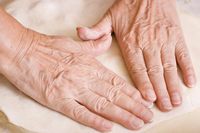
Trick of the Trade: June 2011
May 16, 2011
By
FORMA-LAB
Wherever you go in the world, you’re sure to find pizza on the menu. The
definition of a “great” pizza is not necessarily the same for everyone.
Some people prefer thin crust over thick, or a mountain of meat over a
garden of fresh local veggies. No matter the toppings, all great pizzas
have one thing in common: great dough.
Adding pizza to your product range can help build your bottom line and make your customers happy with a well-loved comfort food
Wherever you go in the world, you’re sure to find pizza on the menu. The definition of a “great” pizza is not necessarily the same for everyone. Some people prefer thin crust over thick, or a mountain of meat over a garden of fresh local veggies. No matter the toppings, all great pizzas have one thing in common: great dough.
 |
|
| For thick crust, stretch the dough from the middle. Advertisement
|
Pizza dough can be made into different shapes, stretched for thin or thick crust, sold garnished, freshly made, parbaked or frozen, and prepared with levain or sourdough. It can be baked on a pizza pan or directly on the stone of a deck oven. Today we also have frozen, rising crusts available for home baking.
To make the dough, use flour from a hard wheat variety. Most restaurants that make their own pizza dough use all-purpose flour, which may be either bleached or unbleached. Industrial operations use a higher protein flour to reinforce the dough. This is especially true for frozen doughs. You can also use whole-wheat flour for variety, or other cereal flours, including rye, buckwheat, oat, spelt, barley, and quinoa. All of these flours can be used with wheat flour. Absorption will vary according to the quantity of each cereal.
Some pizza flours are available, but be sure to do your homework before purchasing these products. Some are prepared from hard wheat and are mostly all-purpose flour. In other words, calling them “pizza flour” may be nothing more than a marketing tactic.
You may also come across pizza mixes, which include all the ingredients for pizza dough, minus the water and yeast. Private label pizza mixes are made according to the specifications of a restaurant chain in order to get consistency and ensure pizzas taste the same from one city to the next.
The basic ingredients in pizza dough are based on total flour weight (flour = 100 per cent):
- salt, which enhances the flavour of all of the other ingredients and controls fermentation (1.5 to 2%)
- sugar, to control the softness of the crust (1.0% for crusty dough to 5.0% for soft dough)
- fat, such as vegetable oil, shortening or lard, in order to facilitate stretching and add tenderness
- (2.0 to 8.0%),
- spices to taste, as desired
- yeast, to help ferment the dough (from 0.25 to 5.0%)
- water, to control the texture of the dough (from 50 to 60%)
Some formulations include other ingredients such as eggs, baking powder, or even 7Up.
Frozen dough will need an improver to guarantee the best result and a long shelf life. Improvers may include an oxidant, an emulsifier, a reducing agent or preservatives.
The key to a great pizza dough lies in the preparation. The texture and taste of the dough depends on the production method used. Many restaurants use the retarded dough method to prepare their dough, mixing the dough with very little yeast, then dividing it according to the desired pizza size and depositing the rounded dough balls onto plastic trays with oil and allowing them to ferment in the fridge for anywhere from six to 36 hours.
In industrial operations, a proofer may be used to speed up the fermentation process, but operations looking to produce frozen dough require a blast freezer.
How you stretch the dough affects the crust of your finished product. The dough can be stretched by hand, by rolling pin or by sheeting machine. We control the thickness of the dough by controlling the weight of the dough. Two dough balls of the same weight can yield either a six-inch thick crust or a nine-inch thin crust pie. To get a nice thick crust, you stretch the dough from the middle and keep the edges thicker. With good fermentation, the crust will rise during baking, giving a great fluffy crust.
To make a pizza, you’ll need a few basic pieces of equipment: a work table, a scale for weighing ingredients, a mixer with enough capacity for the volume you want to produce, a good refrigerator for fermenting dough balls and storing all toppings, and pizza plates of the desired size. You’ll also need a good oven for baking. There are multiple styles of ovens available, including decks, tunnels and rotative ovens powered by gas, electricity or wood. You’ll also need a paddle for removing the pizza from the oven.
The baking temperature will vary from 400 to 550 F, according to death heat or with convection.
The best pizza will be one made with a person’s favourite ingredients, whether it’s prepared by a local pizzeria or by the bakery down the street. The key is preparing the pizza properly to achieve the desired results.
Mario Fortin is an international bakery consultant and owner of FORMA-LAB, a consulting service to bakers and suppliers. If you have a technical problem, send your questions to info@forma-lab.com.
Print this page
Leave a Reply